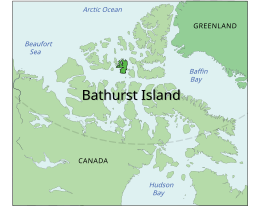 NASA satellite photo montage of Bathurst Island at centre. Viscount Melville Sound, part of the Northwest Passage, adjoins it to the south. | |
 Location of Bathurst Island | |
| Geography | |
|---|---|
| Location | Northern Canada |
| Coordinates | 75°46′N 099°47′W / 75.767°N 99.783°W |
| Archipelago | Queen Elizabeth Islands Arctic Archipelago |
| Area | 16,042 km2 (6,194 sq mi) |
| Area rank | 54th |
| Length | 117 mi (188 km) |
| Width | 63–94 mi (101–151 km) |
| Administration | |
Canada | |
| Territory | Nunavut |
| Demographics | |
| Population | Uninhabited (2021) |
Bathurst Island is one of the Queen Elizabeth Islands in Nunavut, Canada. It is a member of the Arctic Archipelago. An uninhabited island, the area is estimated at 16,042 km2 (6,194 sq mi),[1] 185 to 188 km (115 to 117 mi) long and from 101 km (63 mi) to 116 km (72 mi) to 149.5 km (92.9 mi) wide, making it Canada's 13th largest island. It is located between Devon Island and Cornwallis Island in the east, and Melville Island in the west. Four small islands of Cameron, Vanier, Massey and Alexander lie in its northwest.
The island is low-lying with few parts higher than 330 m (1,080 ft) in elevation. The highest point is 412 m (1,352 ft) at Stokes Mountain in the Stokes Range. This in turn forms part of the Arctic Cordillera mountain system. Good soil conditions produce abundant vegetation and support a more prolific wildlife population than other Arctic islands.
The island contains both the International Biological Program site Polar Bear Pass and Qausuittuq National Park.
History
[edit]The island was first inhabited by Independence I culture peoples around 2000 BC. They were followed by Independence II, Pre-Dorset, and Dorset cultures. On the eastern coast lies Brooman Point Village. The site has been occupied by the Dorset, Paleo-Eskimo and the Thule people around AD 1000, conceivably during a warmer climate episode.[2] At the time of European arrival in the 1800s, nobody was living there, but Inuit in the region likely knew of its abundant wildlife, and possibly travelled there on hunting trips. William Edward Parry was the first European to discover the island in 1819, charting its southern coast.[3] It was named for Henry Bathurst, 3rd Earl Bathurst, British Secretary of State for War and the Colonies 1812–1827. Robert Dawes Aldrich charted much of its west coast in 1851, while George Henry Richards and Sherard Osborn charted its north coast in 1853.[4][5]
The Earth's North magnetic pole tracked northwards across Bathurst and Seymour Islands during the 1960s and 1970s. The Canadian National Museum of Natural Sciences, led by renowned Arctic biologist Stewart D. Macdonald, curator of Vertebrate Ethology, established a permanent High Arctic Research Station there in 1973. Located on the Goodsir River in Polar Bear Pass, the station was staffed seasonally until the 1980s.
See also
[edit]![]() Islands portal
Islands portal
![]() Geography portal
Geography portal
References
[edit]- ^ "Atlas of Canada". Atlas.nrcan.gc.ca. 12 August 2009. Archived from the original on 22 January 2013. Retrieved 30 August 2010.
- ^ Robert McGhee. Brooman Point Village. The Canadian Encyclopedia. Retrieved 26 August 2019.
- ^ Parry, William Edward (1821). Journal of a voyage for the discovery of a North-West passage from the Atlantic to the Pacific: performed in the years 1819-20. London: John Murray.
William Edward Parry 1819.
- ^ Mills, William James (2003). Exploring polar frontiers: a historical encyclopedia. Santa Barbara: ABC-CLIO. ISBN 9781576074220.
- ^ M'Dougall, George F. (1857). The eventful voyage of H.M. discovery ship "Resolute" to the Arctic regions, in search of Sir John Franklin and the missing crews of H.M. discovery ships "Erebus" and "Terror," 1852, 1853, 1854. London: Longman, Brown, Green, Longmans, & Roberts. p. 452.
The Eventful Voyages of HMS Resolute.
Further reading
[edit]- Anglin, Carolyn Diane, and John Christopher Harrison. Mineral and Energy Resource Assessment of Bathurst Island Area, Nunavut Parts of NTS 68G, 68H, 69B and 79A. [Ottawa]: Geological Survey of Canada, 1999.
- Blake, Weston. Preliminary Account of the Glacial History of Bathurst Island, Arctic Archipelago. Ottawa: Department of Mines and Technical Surveys, 1964.
- Danks, H. V. Arthropods of Polar Bear Pass, Bathurst Island, Arctic Canada. Syllogeus, no. 25. Ottawa: National Museum of Natural Sciences, National Museums of Canada, 1980.
- Freeman, Milton M. R., and Linda M. Hackman. Bathurst Island NWT A Test Case of Canada's Northern Policy. Canadian Public Policy, Vol. 1, No. 3, Summer. 1975.
- Givelet, N, F Roos-Barraclough, M E Goodsite, and W Shotyk. 2003. "A 6,000-Years Record of Atmospheric Mercury Accumulation in the High Arctic from Peat Deposits on Bathurst Island, Nunavut, Canada". Journal De Physique. IV, Colloque : JP. 107: 545.
- Hueber, F. M. Early Devonian Plants from Bathurst Island, District of Franklin. Ottawa: Energy, Mines and Resources Canada, 1971.
- Kerr, J. William. Geology of Bathurst Island Group and Byam Martin Island, Arctic Canada (Operation Bathurst Island). Ottawa: Dept. of Energy, Mines and Resources, 1974.
- F.F. Slaney & Company. Peary Caribou and Muskoxen and Panarctic's Seismic Operations on Bathurst Island, N.W.T. 1974. Vancouver: F.F. Slaney & Co. Ltd, 1975.
- Taylor, William Ewart, and Robert McGhee. Deblicquy, a Thule Culture Site on Bathurst Island, N.W.T., Canada. Mercury series. Ottawa: National Museums of Canada, 1981.

